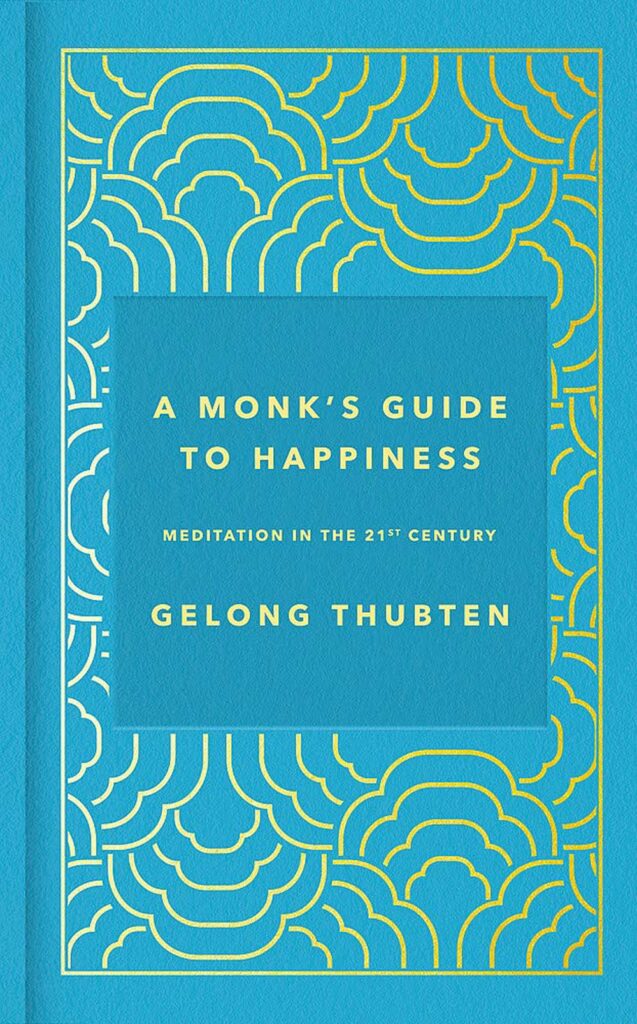Sharing my learnings from the book, A Monk’s Guide to Happiness by Gelong Thubten
A Monk’s Guide to Happiness by Gelong Thubten
Everyone looks externally to find contentment, we think material possessions will unlock our happiness. A Monk’s Guide to Happiness explains how and why we need to look within, and connect to our true essence, in order to find peace. Everyone has the potential to be happy, after all, we’re all ‘hardwired’ for happiness. Gelong Thubten, a Buddhist monk who has worked with everyone from Silicon Valley entrepreneurs to Ruby Wax and Benedict Cumberbatch, explores the theme of happiness in his debut book and explains how to bring meditation into our busy 21st century lives with simple exercises.

- You can develop ability to find peace and happiness no matter where you are or what is going on. In short, on-demand happiness. It’s possible!
- What is happiness?
- sense of fullness – when we’re happy, we feel complete. We feel contented/satisfied.
- feeling anchored to the present – we focus on the present, the moment we’re experiencing.
- Feeling the sense of freedom – we dont get captivated by negative emotions, we feel liberated from all source of unhappiness.
- What is unhappiness?
- when we want something, it’s usually something that we lack but think we should have. The underlying assumption is that happiness comes from outside of ourselves. This is problematic as it puts our happiness at the mercy of outside forces.
- When we get what we desired, we’ll start feeling dissatisfied again with another thing we dont have. This becomes a never-ending loop.
- Modern culture worsens the problem of unsatisfied desires and sense of incompleteness.
- via mechanisms such as advertising, social media and the broader materialistic culture in which we’re embedded with.
- the more accustomed we become to sensory overload, the easier we get bored & distracted, leading us to crave even more.
- Nothing lasts forever. If we look for happiness outside ourselves, we’ll be unhappy.
- We might fear the inevitability of losing them, which spoils our fleeting pleasure with sadness.
- this becomes entrenched as a mental habit, setting us up for continual dissatisfaction.
- Our suffering isn’t caused by the things we want to push away or grasp, but rather by doing these very actions! In order to be happy, we need to let it be.
- If you want to train your mental muscles, you do a powerful mental strength-training called meditation
- Meditation is often misunderstood as simply a method of stress release. The point of meditation is to develop the ability to be happy when we’re not meditating.
- meditation is basically practicing the skill of naturally observing our thoughts, emotions, sensations and experiences.
- we focus our minds on an anchor in the present moment. The objective is to be fully and non-judgmentally focused on whatever we’re experiencing in the moment.
- noticing when we’ve drifted.
- gently bringing our attention back to our anchor.
- You can broaden your meditation practice by implementing mindful moments
- pick 2 or 3 ordinary actions that you usually do mindlessly
- practice the 3 phases of meditation while you perform them each day.
- The more you practice mindfulness, the more it will become your default statement of mind
- Be mindful of how you practice mindfulness meditation
- 1st phase: focus your mind on an anchor, notice if drifted and bring back to your anchor.
- realize that mental wandering isn’t a failure. In fact, it’s pivotal to the success of the whole endeavor
- do not close your eyes or play peaceful music when meditating. The objective isn’t to be mindful while we’re meditating, It’s to be mindful when we’re not meditating


Leave a Reply